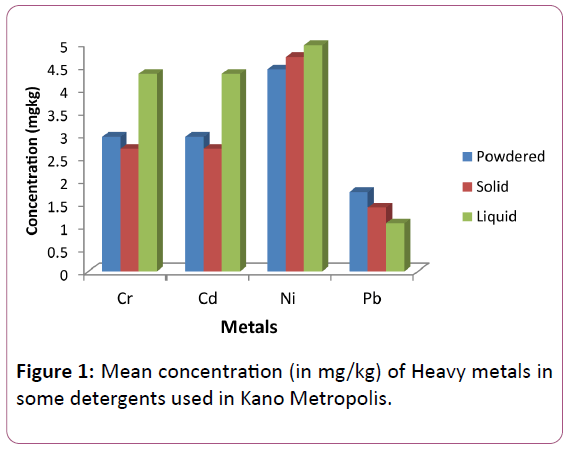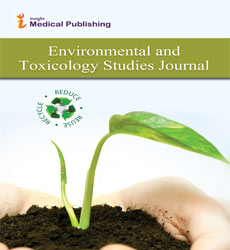Determination of Some Heavy Metals Concentration in Selected Detergents Used in Kano Metropolis, Nigeria
Sani A* and Shehu A
Bayero University, Kano, Nigeria
- *Corresponding Author:
- Sani A
Faculty of Science
Bayero University
Kano, Nigeria
E-mail: asani.bio@buk.edu.ng
Received Date: March 25, 2018; Accepted Date: April 4, 2018; Published Date: April 20, 2018
Citation: Sani A, Shehu A (2018) Determination of Some Heavy Metals Concentration in Selected Detergents Used in Kano Metropolis, Nigeria. Environ Toxicol Stud J. 2:4.
Abstract
There are large amounts of detergent discharged to the environment and subsequently release many organic pollutants and heavy metals. In this Study, twenty detergent samples from three different places were analyzed for Nickel (Ni), lead (Pd) Chromium (Cr) and cadmium (Cd) using Atomic Adsorption Spectrophotometer. The overall mean concentrations of Cd, Cr, Ni and Pb in all samples were 3.42, 3.13, 4.67 and 1.35 mg/kg. Ni has the highest concentration in all the detergents while Lead has the least concentration and are in the range of Ni > Cr > Cd> Pb. The result showed no significant difference in the Cr, Cd, Ni and Pb between powdered, solid and liquid detergents (p>0.05). The high concentration of the heavy metals in the detergents shows that people using the detergents regularly are at risk which over time may accumulate and cause certain health effects to the consumers.
Keywords
Heavy metals; Detergents; Toxic; AAS
Introduction
Detergents are surfactant or a mixture of surfactants that have the cleaning properties in solution. The solution helps in the removal of dirt or other foreign material from contaminated surfaces [1]. Detergents and soap are used for cleaning because pure water can’t remove oily or ground in stain basically allowing oil and water to mix so that oil grime can be remove during rinsing. The ingredients of detergent are often called surface-active or surfactants because they act upon a surface [2]. Detergent are widely use in both industrial premises to wash cloths, equipment, dishes and vehicles. They are also used for many purposes like agricultural purposes and also in dispersing of spills at sea [3]. However, the increasing domestic health hazards and environmental pollution arising from detergent exposure are reducing the popularity of its usefulness [4]. In Nigeria and other countries, only few chemicals have been ecologically tested for safety despite their alleged environmental and ecological impacts [5]. There is no doubt that detergent exposure posed health risks to man and other animals but the doubt lies in what actually it does to them and how dangerous it really is [6]. There are large amounts of detergent discharged to the environment and subsequently release many organic pollutants and heavy metals, which damage the environment and human health. It is therefore important to investigate the content of hazardous substances in detergents [1].
Although detergent is very useful, and contain chemical constituents such as heavy metals which helps in coloring and dirt removal. Improper washing of materials can leave some traces of these detergents which can be taken up in food by ingestion of small amount of the detergent which might cause mild gastrointestinal distress, including vomiting and diarrhea or by dermal absorption as a result of accumulation in hand crevices. Oral exposure might occur from hand-to mouth contact after exposure to detergent containing heavy metal impurities.
Excessive use of these detergents may lead to accumulation of such heavy metals. This became imperative to determine the concentration of some heavy metals in these detergents and the potential risk they might pose. Therefore, this study aims to determine the content of some heavy metals in different detergent brands in Kano Metropolis.
Materials and Methods
Study area
The Study was conducted in Kano State, Nigeria. Three places were selected for sample collection which includes Kasuwar Kurmi (latitude 12.00240 N, longitude 8.51270E), Kasuwar Rimi (latitude 11.97270N, longitude 8.33110E) and Sahad Stores (latitude 11.96720N, 8.53060E).
Sample collection
Twenty (20) detergents were bought from Kasuwar Kurmi, Kasuwar Rimi and Sahad Stores in Kano State. The twenty detergents bought were six (6) powdered, six solid (6) and eight (8) liquid detergents. Samples were dried at approximately 800C for 12 hours.
Sample digestion (Dry Ashing)
1 g of the samples was dried ashed in a muffle furnace at 475-500°C for 2-4 hours. After which the ash was removed from the muffle furnace, cooled and dissolved in 5 ml of 20% (2M) HCl in a volumetric flask and warmed. The solution was filtered through an acid washed filter paper into a 50 ml volumetric flask. It was then diluted after cooling with distilled water [7].
Elemental analysis
Chromium (Cr), Cadmium (Cd), Nickel (Ni) and Lead (Pb) were determined using atomic absorption spectrophotometer (Model 210 VGP) equipped with flame and graphite furnace. Air acetylene flame was used for determination of metal content. Instrument parameters are usually given by the manufacturers in the manual provided with the instrument. The absorbance of the sample solutions was determined and the heavy metal content was calculated from standard curve [8]. Each value was recorded at 217 nm for Cd, 262 nm for Cr, 283.3 nm for Pb and 260 nm for Ni.
Statistical analysis
One-way ANOVA was applied to assess the statistically significant differences. Significant difference was taken at p<0.05. Sigma stat V.3.5. package was used for the analysis.
Results
Discussion
The overall mean concentrations of Cd, Cr, Ni and Pb in all samples were 3.42, 3.13, 4.67 and 1.35 mg/kg. In Akure, Abulude et al. reported that the findings with regard to Pb, Cr and Cd content were lower compared to this study [9]. Figure 1 shows that liquid detergents has the highest concentration of Ni followed by Cr, Cd and subsequently Pb. Heavy metals in powdered and solid detergents are in the order Ni > Cr > Cd. The concentration of Pb is low in solid and liquid detergent and relatively higher in powdered detergents.
The mean Cd concentration was 3.13 mg/kg and in the range of 1.54-6.92 mg/kg in all detergents. Similarly, the Cd content reported for young coots from industrial and agricultural regions of North middle Poland by Szarek et al. was slightly lower than this result [10]. Cadmium is also toxic at extremely low levels in humans, long term exposure result in renal dysfunction characterized by tubular proteinuria. Renal effects may cause following sub chronic inhalation exposure to cadmium and its compounds [11]. The Cr concentration ranges from 0.83-5.83 mg/kg in all the detergents. The range of Ni concentration in all detergents analyzed was 1.56-7.81 mg/kg. It has been shown that the induction of Ni contact allergy is dependent on the amount of Ni per skin unit area present in the epidermis [12]. A limit of 0.5 mg/cm2 per week of nickel release was suggested as a safe limit for nickel exposure [13]. A number of metals and their compounds may cause adverse reaction upon contact with the skin [14]. Although some are toxic, causing irritant contact dermatitis, ulceration or granuloma, the most common effect is contact allergy. Nickel is the most common cause of contact allergy of all skin sanitizers, and it is also an important cause of hand eczema. Sensitization to nickel is generally caused by direct and prolonged skin contact with items that release nickel ions. The detergents seem to have little concentration of lead. A safe limit for lead is yet to be scientifically established, but many studies have indicated that it can be harmful at very low levels. The range of Pb is 0.55-2.20 mg/kg in all detergents in this study. Lead can be absorbed through the skin and although studies on the dermal absorption of lead in humans are still scares, damaged skin, pH, and metallic chemical structure are likely factors that could enhance percutaneous penetration of metals [15]. Liley et al. suggested that lead absorbed through the skin may be eliminated via sweat and other extracellular fluids and hence not be as great a health hazard as ingested lead. Notwithstanding, lead accumulate in the body over time and exposure to lead-containing detergents whether a number of times a day or on daily basis can contribute to significant lead exposure levels. Statistical analysis showed no significant difference in the Cr, Cd, Ni and Pb between powdered, solid and liquid detergents (p>0.05) [16].
Conclusion
In conclusion, the overall mean concentrations of Cd, Cr, Ni and Pb in all samples were 3.42, 3.13, 4.67 and 1.35 mg/kg. The results obtained shows that Ni, Cr and Cd were higher in all the detergents. Meanwhile, Pb shows less concentration in the detergents. There is relatively high level of Ni and low level of Pb. The high concentration of the heavy metals in the detergents shows that people using the detergents regularly are at risk which over time may accumulate and cause certain health effects to the consumers.
Recommendations
• Detergents and Soap manufacturing industries in Nigeria are required to improve in the area of purification of raw materials used in making soaps or avoid completely the usage of any materials that contains the dangerous heavy metals during detergent production.
• Monitoring the usage of these detergents should be enforced to reduce environmental hazards.
• A thorough investigation on the health risk, heavy metals concentration and ecological disorders that may arise from improper handling and disposal of detergents.
References
- Longman GF (1975) The analysis of detergent and detergent products, Wiley Interscience, John Wiley and sons pp: 152-159.
- Gaus LG (2009) Microsoft Encarta, Microsoft Corporation.
- Lightowlers P (2004) Still dirty: A review of action against toxic products in Europe. A report for WWF-UtK.
- Ezemonye L, Enuneku A (2005) Evaluation of acute toxicity of cadmium and lead to amphibian tadpole (toad: Bufomaculatus and frog: ptychadenabibroni) and frog. J Aquat Sci 20: 33-36.
- Ogundiran MA, Fawole OO, Adewoye SO, Ayandiran TA (2010) Toxicological impact of detergent effluent on juvenile of African Catfish (Clarias gariepinus) (Buchell 1822). Agric Bio J North Am 1: 330-342.
- Easy Essay (2007) Effects of laudry detergent on the environment.
- Mercedes R (2002) Heavy metals and arsenic uptake by wild vegetation in the guadiamar river area after the toxic spill of the aznalcollar mine. J Biotechnol 98: 125-137.
- Levinson R (2001) More Modern Chemical Techniques, Royal Society of Chemistry, London.
- Abulude FO, Ogunkoyam MO, Ogunleye RF, Emidun O, Abdulude AI (2007) Assessment of the content of Pb, Cd, Ni and Cr in Soal and Detergent from Akure, Nigeria. Res J Environmental Toxicology 1: 102-104.
- Szarek J, Felsmann MZ, Kmarkiewicz E, Felsmann M (2001) Cadmium levels and in young soot originating from industrial and agricultural regions of north middle Poland. Polish J Environ Stud 10: 489-491.
- McCluggage D (1991) Heavy Metal Poisoning, NCS Magazine. The Bird Hospital, Columbus.
- Flint GN (1998) A metallurgical approach to metal contact dermatitis. Contact Dermatitis 39 :213-221.
- Menné T, Brandrup F, Thestrup-Pedersen K, Veien NK, Andersen JR, et al. (1987) Patch test reactivity to nickel alloys. Contact Dermatitis 16: 255-259.
- Lide´n C, Skare L, Lind B, Nise G, Vahter M (2006) Assessment of skin exposure to nickel, chromium and cobalt by acid wipe sampling and ICP-MS. Contact Dermatitis 54: 233-38.
- Larese FF, Mark BB, Giovanni M, Gianpiero A, Paolo S, et al. (2006) Skin Absorption of Inorganic Lead (PbO) and the Effect of Skin Cleansers. J Occup Environ Med 48: 692-699.
- Lilley SG, Florence T, Stauber JL (1988) The use of sweat to monitor lead absorption through the skin. Sci Total Environ. 76: 267-278.
Open Access Journals
- Aquaculture & Veterinary Science
- Chemistry & Chemical Sciences
- Clinical Sciences
- Engineering
- General Science
- Genetics & Molecular Biology
- Health Care & Nursing
- Immunology & Microbiology
- Materials Science
- Mathematics & Physics
- Medical Sciences
- Neurology & Psychiatry
- Oncology & Cancer Science
- Pharmaceutical Sciences

